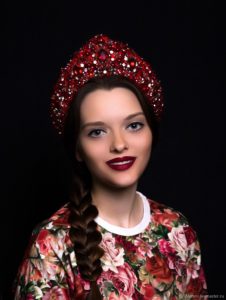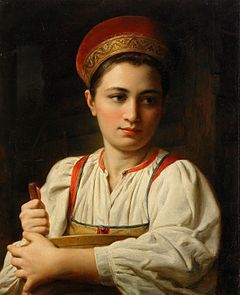The beauty and appearance of ancient Russian women aroused praise from other peoples. Each person has his own opinion, his own views on the ideal of beauty, but everyone has the same opinion regarding Russian women, they have always been described with elegance, noted for their snow-white skin with blush on their cheeks, beautiful, long hair. By the style of the headdress, everyone could recognize its owner, age, family and financial status. The most popular decoration for married women was kokoshniks.
 Kokoshniks were made of bright fabric and very richly decorated. Such clothes were made by craftswomen over many days. They were preserved very carefully. The types of kokui were very diverse. The dresses are so traditional that one could use them to determine the owner’s habitat.
Kokoshniks were made of bright fabric and very richly decorated. Such clothes were made by craftswomen over many days. They were preserved very carefully. The types of kokui were very diverse. The dresses are so traditional that one could use them to determine the owner’s habitat.
What does a kokoshnik consist of?
 Kokoshnik - an ancient Russian headdress for ladies, in the shape of a crest (crescent) around the head, with a painted front part, which is located high above the forehead. Ribbons are attached to the back.Symbol of Russian traditional costume. Derived from kokosh “chicken” and “rooster”. This name comes from the comparison of the headdress with the crest of a bird. The face becomes the center of attention. In addition, the kokoshnik emphasizes the importance of the event.
Kokoshnik - an ancient Russian headdress for ladies, in the shape of a crest (crescent) around the head, with a painted front part, which is located high above the forehead. Ribbons are attached to the back.Symbol of Russian traditional costume. Derived from kokosh “chicken” and “rooster”. This name comes from the comparison of the headdress with the crest of a bird. The face becomes the center of attention. In addition, the kokoshnik emphasizes the importance of the event.
On a note! The purpose of the decoration is to tightly cover the hair and hide long hair.
 Depending on the place of residence in different territories of Russia, their own unique form of kokui was formed, which was determined by various characteristics: the peculiarity of hair styling, tied in two braids (they could braid it around the head, above the forehead, on the back of the head, etc.), a variety of decorations and inserts. To add beauty to the image, velvet blades and beaded edges, cuffs and other details were added, the basis for which was a kokoshnik.
Depending on the place of residence in different territories of Russia, their own unique form of kokui was formed, which was determined by various characteristics: the peculiarity of hair styling, tied in two braids (they could braid it around the head, above the forehead, on the back of the head, etc.), a variety of decorations and inserts. To add beauty to the image, velvet blades and beaded edges, cuffs and other details were added, the basis for which was a kokoshnik.
According to their design, there are 4 types of kokoshniks:
- one-horned,
- cylinder shape with flat top,
- ellipse shape,
- double-combed.
The kokoshnik consists of the following parts:
- head;
- hair (bottom);
- lower;
- slap;
- eyeglasses;
- blades.
What were the components of the kokoshnik made from?
 Kokosh had a high eyeglasses with lace details and a pearl bottom (bottom), round velvet bottom and beaded nape. On the side hung pendants made of beads or other beads. When put on, it was slightly shifted onto the forehead, and the back of the head was made of canvas, secured with ribbons. Kokui looked like a light fan.
Kokosh had a high eyeglasses with lace details and a pearl bottom (bottom), round velvet bottom and beaded nape. On the side hung pendants made of beads or other beads. When put on, it was slightly shifted onto the forehead, and the back of the head was made of canvas, secured with ribbons. Kokui looked like a light fan.
 Support was made on a strong base of damask and velvet, calico on a strong base (canvas, cardboard, cap material). The soft part was necessarily sewn by measuring the head of the owner of the dress. The top of the comb was decorated with patterned braid, beads or pearls, and complex lace, which added even more admiration to the outfit.
Support was made on a strong base of damask and velvet, calico on a strong base (canvas, cardboard, cap material). The soft part was necessarily sewn by measuring the head of the owner of the dress. The top of the comb was decorated with patterned braid, beads or pearls, and complex lace, which added even more admiration to the outfit.
 Floral patterns and stylized birds were often used as examples for embroidery patterns. On the back of the head, ornaments were often made with gold threads. And at the back the kokuya was secured with silk ribbons. The edge could be decorated with cassocks, falling pearls (or other material) threads, this allowed not very young ladies to hide the signs of age on their faces. Scarves or a light veil could be worn on top of the kokoshnik; the attributes were draped with lace and patterns. Scarves were fastened under the chin or lowered from the top of the kokush, onto the shoulders or back.
Floral patterns and stylized birds were often used as examples for embroidery patterns. On the back of the head, ornaments were often made with gold threads. And at the back the kokuya was secured with silk ribbons. The edge could be decorated with cassocks, falling pearls (or other material) threads, this allowed not very young ladies to hide the signs of age on their faces. Scarves or a light veil could be worn on top of the kokoshnik; the attributes were draped with lace and patterns. Scarves were fastened under the chin or lowered from the top of the kokush, onto the shoulders or back.
What is the name of the back part of the kokoshnik and what are its functions?
 The back part was called the cuff. It was made of tight material, beautiful velvet. In winter, sable or beaver fur was used to protect the head from the cold. Then the kokoshnik became even more beautiful. The cuff served to cover the seams of the product. When the kokui was made of thin fabric, girls could tie it with ribbons at the chin, or make a beautiful large bow at the back of the head.
The back part was called the cuff. It was made of tight material, beautiful velvet. In winter, sable or beaver fur was used to protect the head from the cold. Then the kokoshnik became even more beautiful. The cuff served to cover the seams of the product. When the kokui was made of thin fabric, girls could tie it with ribbons at the chin, or make a beautiful large bow at the back of the head.
Now many kokoshinichki are kept in museums and personal collections. In modern culture, this headdress is an indispensable attribute of the New Year's costume of the Snow Maiden, Queen Amidala in the film Star Wars, and is also used in other areas.


 0
0





